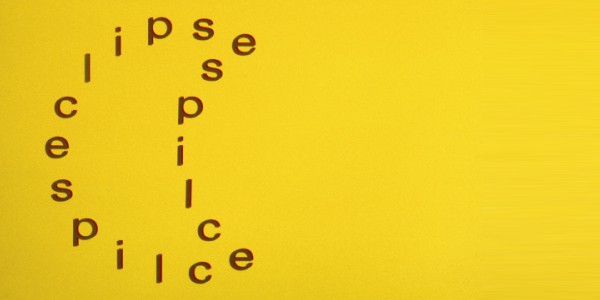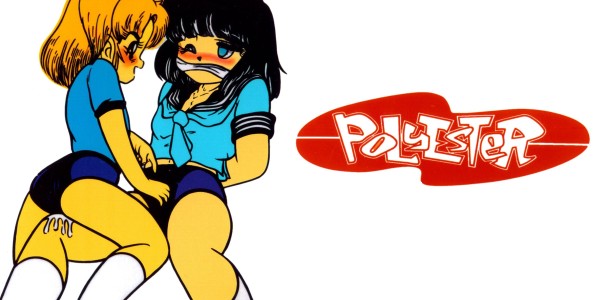The piece looks down on more horizons and was created by Alex Selenitsch, a friend of Reed who made the pieces after Sweeney’s death, a response but also a completion of the theme that he felt his friend wasn’t quite done with. “Sweeney died rather untimely in 1979, quite young, and Alex always felt that perhaps that project wasn’t quite finished, so he’s made these new works quite recently in response to his work,” explains curator Linda Short in a soft Scottish lilt.
The works range from sculpture to print, publications and paintings. “The name ‘concrete poetry’ I guess it would have come out through… there was already an art concrete movement, music concrete, but in concrete poetry it’s not the idea that concrete means abstract, which it does really in fine art and music, but really that it is something that existed, so it was poetry that could exist in the world,” Short explains of the somewhat convoluted matter of taxonomy of genres.
The exhibition is made up of works from the Heide collection from the ’60s onwards, when concrete poetry became popular in Australia, together with some borrowed pieces. “We have a lot of works by Alan Riddell who was an important concrete poet. He was a journalist and he also held a very early exhibition of concrete poetry – just after Alex, it’s almost like they battled for who was the first,” says Short. Riddell’s Eclipse series is pretty self-explanatory. “Often in concrete poetry you see [an] image and the words spell and out and shape something very visual and here you’ve got the word ‘eclipse’ forming a solar eclipse, and they’re called calligrams.
“I started working here about 2005 and I was always interested in concrete poetry particularly Ian Hamilton [Finlay]’s work, being Scottish,” she goes on. “When I came to Heide I discovered that Sweeney Reed (who’s obviously a very important figure historically here at Heide) had collaborated with Finlay and they were planning to publish a book of Sweeney’s poems just before Sweeney died. When I found that connection I thought, oh this is something I really want to explore.” Short worked with fellow Heide curator, Katarina Paseta to put together the exhibition.
The book was never released, but a draft existed at the State Library Of Victoria and has been loaned to display at Heide. “They had this dummy book which has been hand-written by Findlay,” says Short. These were the poems that the book was to contain. As far as we know it was never realised, but it was really interesting to see that artists and poets in Australia were corresponding with people overseas. There are some lovely connections between Sweeney’s work and Finlay’s work. They’re both really interested in the symbolism of the rose and nature and there’s a real gentleness in their work – sort of romance.”
Upstairs more cases display works made for publication, and it’s here that most of the work by female artists resides. “The title of the show, ‘Born To Concrete’, comes from this journal here,” points out Sharp. “There were only a small number of issues.”
One cabinet displays painstakingly hand made cards and letters. “This is a recent gift from the estate of Ruth Cowen, who never reallyclassed herself as an artist or a poet,” says Sharp. Cowen’s artist statement confirms this: “For a long time all the poems I did were for friends’ birthdays, or for Christmas or St. Valentine’s Day. Poemes d’occasion. It is only in the last few years that I have done some un-occasional poems as well but even those are always sent to special friends. So all the poems I do are for people not for posterity. Concrete letters.”
“This one here’s for Alex Selenitsch, who is the artist who we’ve got downstairs,” says Short, another fitting connection in a house which once brought artists and intellectuals together. A print above the cabinet implores over and over ‘TRYPOETRY’. “I love this one,” beams Short.
Moving onto more recent work, white writing on black board presents Aleks Danko’s riddles. “These are very recent works,” says Short. “Language is very important in [Danko’s] work and he often uses it as a way to set up an interaction with the viewer. So when we were looking at these works here, he made Katrina and [me] stand in front of them and work them out. When you’re put on the spot I couldn’t work them out at first. This one’s called poetic suicide,” Short explains, considering an alphabet with letters missing. “It took me forever to work this one out, but he’s actually taken out the letters from his surname, Danko, so he’s symbolically committed poetic suicide by taking himself out of the poem.”
There’s plenty to consider at Born To Concrete, or perhaps just go along and take in some fabulous typography, or hang out in a truly spectacular building with serious art history.

